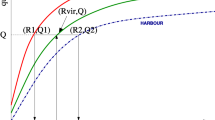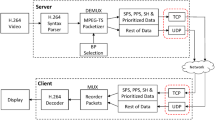Abstract
Internet video streaming is a widely popular application however, in many cases, congestion control facilities are not well integrated into such applications. In order to be fair to other users that do not stream video, rate adaptation should be performed to respond to congestion. On the other hand, the effect of rate adaptation on the viewer should be minimized and this extra mechanism should not overload the client and the server. In this paper, we develop a heuristic approach for unicast congestion control. The primary feature of our approach is the two level adaptation algorithm that utilizes packet loss rate as well as receiver buffer data to maintain satisfactory buffer levels at the receiver. This is particularly important if receiver has limited buffer such as in mobile devices. When there is no congestion, to maintain best buffer levels, fine grain adjustments are carried out at the packet level. Depending on the level of congestion and receiver buffer level, rate shaping that involves frame discard and finally rate adaptation by switching to a different pre-encoded video stream are carried out. Additive increase multiplicative decrease policy is maintained to respond to congestion in a TCP- friendly manner. The algorithm is implemented and performance results show that it has adaptation ability that is suitable for both local area and wide area networks.
Similar content being viewed by others
References
D. Bansal and H. Balakarishnan, “Binomial congestion control algorithms,” in Proceedings of the IEEE Infocom Conference, Anchorage, AK, 2001, pp. 631–640.
A. Basso, G.L. Cash, and M.R. Civanlar, “Real-time MPEG-2 delivery based on RTP: Implementation issues,” Image Communication, Special Issue on Video Over the Internet, pp. 165–178, 1999.
W. Dabbous, “Analysis of a delay-based congestion avoidance algorithm,” in Proc. 4th IFIP Conf. High Performance Networking, 1992, pp. 283–298.
N. Feamster, “Adaptive delivery of real-time streaming video,” MsC. Thesis, Electrical Engineering and Computer Science Dept., MIT, 2000.
J.C. Guerri, M. Esteve, C. Palau, and V. Casares “Feedback flow control with hysteresial techniques for multimedia retrievals,” Multimedia Tools and Applications, No. 13, pp. 307–332, 2001.
D. Hoffman, G. Fernando, V. Goyal, and M. Civanlar, “RFC2250: RTP payload format for MPEG1/MPEG2 video,” January 1998.
J.-Y. Jee, T.-H. Kim, and S.-J. Ko, “Motion prediction based on temporal layering for layered video coding,” in Proceedings of ITC-CSCC, 1998, pp. 245–248.
M. Kalman, B. Girod, and E. Steinbach “Adaptive playout for real-time media streams,” in Proceedings of ISCAS2002, Invited paper, 2002.
M. Kalman, E. Steinbach, and B. Girod, “Rate distortion optimized video streaming with adaptive playout,” in Proceedings of ICIP2002, 2002, pp. 189–192.
A. Kantarci and E.T. Tunali, “Design and implementation of a streaming system for MPEG-1 videos,” Journal of Multimedia Tools and Applications, to be published in 2003.
M. Masry and S.S. Hemami, “An analysis of subjective quality in low bit rate video,” in Proc. ICIP'01, Thesaloniki, Greece, 2001, pp. 465–468.
S. McCanne, M. Vetterli, and V. Jacobson, “Low-complexity video coding for receiver-driven layered multicast,” IEEE Journal on Selected Areas in Communications, Vol. 15, No. 6, 1997 pp. 983–1001.
R. Rejaie, M. Handley, and D. Estrin, “Layered quality adaptation for internet video streaming,” IEEE Journal of Selected Areas of Communications, Vol. 18, No 12, pp. 2530–2543, 2000.
N. Seelam, P. Sethi, and W. Feng, “A hysteresis based approach for quality, frame rate, and buffer management for video streaming using TCP,” MMNS 2001, LNCS 2216, 2001, pp 1–15.
T. Sikora, “MPEG digital video-encoding standards,” IEEE Signal Processing Magazine, Vol. 14, No. 5, pp.82–100, 1997.
X. Wang and H. Schulzrinne, “Comparison of adaptive internet multimedia applications,” IEEE Transactions on Communications, Vol. 82, No. 12, pp. 806–818, 1999.
D. Wu, Y.-T. Hou, and Y.-Q. Zhang, “transporting real-time video over the intenet:challenges and approaches,” in Proceedings of the IEEE, Vol. 88, No. 12, pp. 1855–1875, 2000.
D. Wu, Y.-T. Hou, W. Zhu, H.-J. Lee, T. Chiang, Y.-Q. Zhang, and H.J. Chao, “On end-to-end architecture for transporting MPEG-4 video over the internet,” IEEE Transactions on Circuits and Systems for Video Technology, Vol. 10, No. 6, pp. 923–941, 2000.
D. Wu, Y.-T. Hou, W. Zhu, Y.-K. Zhang, and J.M. Peha, “Streaming video over the internet: Approaches and directions,” IEEE Transactions on Circuits and Systems for Video Technology, Vol. 11, No. 1, pp. 282–300, 2001.
R. Zhang, S.L. Regunathan, and K. Rose, “Video coding with optimal inter/intra-mode switching for packet loss resilience,” IEEE Journal on Selected Areas in Communications, Vol. 18, No. 6, pp. 966–976, 2000.
Author information
Authors and Affiliations
Corresponding author
Additional information
E. Turhan Tunali received B.Sc. Degree in Electrical Engineering from Middle East Technical University and M.Sc. Degree in Applied Statistics from Ege University, both in Turkey. He then received D.Sc. Degree in Systems Science and Mathematics from Washington University in St. Louis, U.S.A. in 1985. After his doctorate study, he joined Computer Engineering Department of Ege University as an assistant professor where he became an associate professor in 1988. During the period of 1992–1994, he worked in Department of Computer Technology of Nanyang Technological University of Singapore as a Visiting Senior Fellow. He then joined International Computer Institute of Ege University as a Professor where he is currently the director. In the period of 2000–2001 he worked in Department of Computer Science of Loyola University of Chicago as a Visiting Professor. His current research interests include adaptive video streaming and Internet performance measurements. Dr. Tunali is married with an eighteen year old son.
Aylin Kantarci received B.Sc., M.Sc. and Ph.D. degrees all from Computer Engineering Department of Ege University, Izmir, Turkey, in 1992, 1994 and 2000, respectively. She then joined the same department as an assistant professor. Her current research interests include adaptive video streaming, video coding, operating systems, multimedia systems and distributed systems.
Nukhet Ozbek received B.Sc. degree in Electrical and Electronics Engineering from School of Engineering and M.Sc. degree in Computer Science from International Computer Institute both in Ege University, Izmir, Turkey. From 1998 to 2003 she worked in the DVB team of Digital R&D at Vestel Corporation, Izmir-Turkey that produces telecommunication and consumer electronics devices. She is currently a Ph.D. student and a research assistant at International Computer Institute of Ege University. Her research areas include video coding and streaming, multimedia systems and set top box architectures.
Rights and permissions
About this article
Cite this article
Tunali, E.T., Kantarci, A. & Ozbek, N. Robust Quality Adaptation for Internet Video Streaming. Multimed Tools Appl 27, 431–448 (2005). https://doi.org/10.1007/s11042-005-4090-9
Issue Date:
DOI: https://doi.org/10.1007/s11042-005-4090-9




